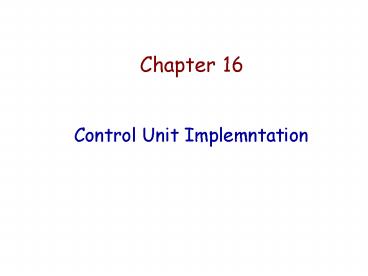Control Unit Implemntation - PowerPoint PPT Presentation
Title:
Control Unit Implemntation
Description:
Chapter 16 Control Unit Implemntation A Basic Computer Model Example Simple Processor & Data Paths MIPS Data Paths with Generation of Control Signals A Simple ... – PowerPoint PPT presentation
Number of Views:135
Avg rating:3.0/5.0
Title: Control Unit Implemntation
1
Chapter 16
- Control Unit Implemntation
2
A Basic Computer Model
3
Example Simple Processor Data Paths
4
MIPS Data Paths with Generation of Control
Signals
Note This figure does not show J (jump) type
instruction Data Paths
5
A Simple Computer its Control Unit
6
Control Signal Sources
- Clock
- One micro-instruction (or set of parallel
micro-instructions) per clock cycle - Instruction Register
- Op-code for current instruction
- Determines which micro-instructions are performed
- Flags
- State of CPU
- Results of previous operations
- From Control Bus
- Interrupts / Bus Requests
- Acknowledgements
7
Control Signals Outputs
- Within CPU
- Cause data movement
- Activate specific functions
- Via Main Bus
- To memory
- To I/O modules
8
Control Signals
9
The Internal Bus ?
10
Example Simple Processor Data Paths
11
Example Simple Processor Data Paths
12
State Machine for Example Simple Processor
http//highered.mcgraw-hill.com/sites/dl/premium/0
072467509/instructor/104653/figurec9.xls
13
Control Unit with Decoded Inputs
14
MIPS Instruction Formats
15
MIPS Data Paths with Generation of Control
Signals
Note This figure does not show J (jump) type
instruction Data Paths
16
MIPs Pipelined Machine with Controls
IF ID
EX MEM
WB
(142 bits)
(107 bits)
(71 bits)
(64 bits)
17
Problems With Hard Wired Designs
- Sequencing micro-operation logic gets complex
- Difficult to design, prototype, and test
- Resultant design is inflexible, and difficult to
build upon - (Pipeline, multiple computation units, etc.)
- Adding new instructions requires major design and
adds complexity quickly
18
Chapter 17
- Micro-Programmed Control
19
Example Simple Processor Micro-Programed Control
20
Control Unit Organization
The Control Memory contains sequences of
microinstructions that provide the control
signals to execute instruction cycles, e.g.
Fetch, Indirect, Execute, and Interrupt.
- Tasks of Control Unit
- Microinstruction sequencing
- Microinstruction execution
May be expected to complete instruction execution
in 1 clock cycle. How is this possible?
21
Recall Micro-sequencing
22
Example of Control Memory Organization
- Microinstructions
- Generate Control Signals
- Provide Branching
23
Horizontal vs Vertical Microprogramming
- Horizontal Microprogrammed or
- Unpacked
- Hard
- Direct
- Vertical Microprogrammed or
- Packed
- Soft
- Indirect
24
Microinstruction Encoding - Direct Encoding
25
Microinstruction Encoding - Indirect Encoding
26
Horizontal Micro-programming
- Wide control memory word
- High degree of parallel operations possible
- Little encoding of control information
- Faster
27
Vertical Micro-programming
- Width can be much narrower
- Control signals encoded into function codes
need to be decoded - More complex, more complicated to program, less
flexibility - More difficult to modify
- Slower
28
Typical Microinstruction Formats
29
Example Microprogramming Formats
- MicroProgram Counter
- Subroutines
- Stack
- Control Register (MicroProgram Format)
30
Next Address Decision
- Depending on ALU flags and control buffer
register - Get next instruction
- Add 1 to control address register
- Jump to new routine based on jump
microinstruction - Load address field of control buffer register
into control address register - Jump to machine instruction routine
- Load control address register based on opcode in
IR
31
Microprogrammed Control Unit
32
Design Considerations
- Necessity of speed
- Size of Microinstructions
- Address generation
- Branches
- Both conditional and unconditional
- Based on current microinstruction, condition
flags, contents of IR - Based on format of address information
- Two address fields
- Single address field
- Variable format
33
Branch Control Two Address Fields
- Branch based upon
- Instruction Opcode
- Address 1
- Address 2
- Does require a wide microinstruction, but no
address calculation is needed
34
Branch Control Single Address Field
- Branch based upon
- Next instruction
- Address
- Opcode
- Does require more
- circuitry, e.g. adder
35
Branch Control Variable Format
- One bit determines microinstruction format
- Control signal format
- Branch format
- Does require even more circuitry, and is slowest.
36
Advantages and Disadvantages of Microprogramming
- Advantage
- Simplifies design of control unit
- Cheaper to design
- Less error-prone
- Much easier to modify
- Supports having multiple versions / models
- Disadvantage
- Slower
- More expensive to produce in quantities































